Project Overview
Annual Reports
Commodities
- Agronomic: general grain crops
Practices
- Education and Training: on-farm/ranch research
- Production Systems: general crop production
- Soil Management: organic matter, soil quality/health
Summary:
PROJECT BACKGROUND
Schweihofer Farms is a crop/livestock operation with approximately 1,000 acres of crops grown annually. Our rotation includes corn, soybeans, wheat, and alfalfa/grass hay. The livestock portion includes 150 cattle in a beef feedlot and 15 llamas used in a breeding operation. We use vertical tillage for corn production and no-till for soybean and wheat production. In addition to the farm, my wife Jeannine and I have started Schweihofer Seed Sales LLC, as a way to increase our net farm income. Our farm is a fourth generation farm and we have been actively trying to build the soils. We have a combination of soil textures that range from heavy clay to sandy loam and they continue to be a challenge. In both the clay soils and the sandy loams we have limited soil organic matter. While manure has been one way for us to build soil organic matter there are insufficient amounts for the acres we farm. I have been actively involved in the area and previously served as the president of the St. Clair County Farm Bureau.
Our farm has been practicing no-till for the past 13 years. Vertical tillage is used on corn acreage in recent years.
PROJECT DESCRIPTION
GOALS
Compost has been used in many different types of farming operations primarily in horticulture and vegetable production; however in this area there has not been a source of compost large enough to supply the needs of grain crop farmers in the area. The objective of this grant is to find out how much compost should be applied in a corn/soybean rotation to see a sustainable response and then consider the economic sustainability. The goal was to determine if an economical rate of compost will maintain crop yields, increase soil quality, and reduce commercial fertilizer use.
PROCESS
Each farmer cooperator applied yard compost (commercially composted grass, leaves, and branches) at a rate of 5 ton/acre plus a control for two years. The 2.5 ton/acre treatment was eliminated because it was too difficult to calibrate the spreading of compost at that rate. The compost was applied in the same field at each of the three farms with a corn/soybean rotation.
Strips up to 1200 feet long, and wide enough to combine (dependent on each farms harvesting equipment), were established to receive compost in the spring and be incorporated into the soil prior to planting. Each application was done using a rear beater-bar spreader. The side slinger spreader did not work because the application rate could not be controlled and the compost remained in the bottom of the spreader. A random complete block design was used with three or four replications on the same strips for each year of the corn and soybean field. Normal fertilizer rates were applied to the fields as the compost builds soil quality, and soil organic matter. Soil tests pre and post testing were taken for each field to determine the level of soil buildup at the completion. Woods End Soil Laboratory (Mount Vernon, ME) utilized the USDA-ARS H3A Extraction Method soil test. In addition, they utilized Solvita CO2 respiration Yield, moisture and test weight were measured for each replication and treatment.
PEOPLE
Steve Listwak, farmer, project collaborator
2960 Burnside Road
North Branch, MI 48461
Crop/livestock farm in combination with a beef cow/calf grazing operation. The cropping operation is approximately 275 acres of owned and rented land, which includes 50 irrigated acres, 40 acres of pasture, and 80 acres of alfalfa/grass mix. Crops include corn, soybeans, rye, alfalfa, and grass. The livestock operation includes 35 Angus crossed brood cows. Soil textures are predominantly sandy loams.
Gordon Spencer, farmer, project collaborator
Spencer Farms Inc.
8151 Dryden Road
Almont, MI 48003
Spencer Farms is a cash cropping system of 1760 acres that includes 130 acres of wheat and a 50:50 corn soybean rotation. Combinations of conventional tillage, vertical tillage and no-till are all used in the operation. No-till is used primarily for wheat and soybean acres. To build soil quality, the farm has started using cereal rye as a cover crop. Soil textures range from clay loams to sandy loam.
Phil Kaatz, Michigan State University Extension Educator
Forages/Field Crops
1800 Imlay City Rd.
Lapeer, MI 48446
Mr. Kaatz was involved with the planning, execution and outreach components of the project. He has been influential in the region regarding compost usage in cropping systems and has helped initiate projects to evaluate the use of yard waste compost. He has statewide responsibilities for forages and also has field crops responsibilities in a nine county area that includes 40% of Michigan’s corn production.
Charles Gould
Michigan State University Extension Educator
Bioenergy and Energy Conservation
12220 Fillmore St, Suite 122
West Olive, MI 49460
Mr. Gould participated as a speaker at both summer field days. He has extensive experience with compost and utilizing it in various farming operations.
Bob Brooks
Fred Thompson
Indian Summer Recycling
5877 Bethuy Rd.
Casco Twp., MI 48064
Mr. Brooks and Mr. Thompson are owners and operators of Indian Summer Recycling and provided the yard waste compost for the project.
RESULTS
Overall observations for the project include: Do not expect short-term miracles in increased soil health and fertility using compost. Research indicates that it takes three years to change the microbial population in the soil. Compost varies in composition from year to year depending on the makeup of the incoming materials. Two years appears to be too short of a time to be a value over and above the cost of the compost plus application costs. A combination of compost, manure, and cover crops may provide added benefits to increased soil activity, fertility, and health. The benefits should continue for more than one year after application. Long term benefits of compost include: improving CEC, building soil organic matter, improving aggregate stability, better pore spaces in the soil, stimulation of the microbial population, and increased water holding capacity.
The economic feasibility of using the yard waste compost includes assumptions at these values: corn price $3.30/bushel, compost cost $7.00/ton (yard), freight cost $4.00/ton (yard) ($200/load = distance charge, each load is 50 yards), application cost $4.00/ton (yard).
Compost analysis:
The North Branch project cooperator tried compost application the year prior (2013) to the start of this project and had three years of data. The crop response was greater this year than in any previous year. There was a statistical yield difference in 2015. There was a dramatic visual difference in the corn during the growing season as well. Crop response was greater than the cost of the compost for this site. There was a consistent yield response over a three year period at this site.
The Almont site had a tremendous corn crop in 2015 with an average of 250 bushels/acre. In 2014, there was a 15% prevalence of white mold present in the soybeans and no difference was seen between the compost trial and the control.
The China site was not able to use the 2015 data because of extreme amounts of rainfall experienced from just after the time of planting throughout the growing season. The yield data had high variability. There was a trend for a 6.3% increase in soybean yield in 2014.
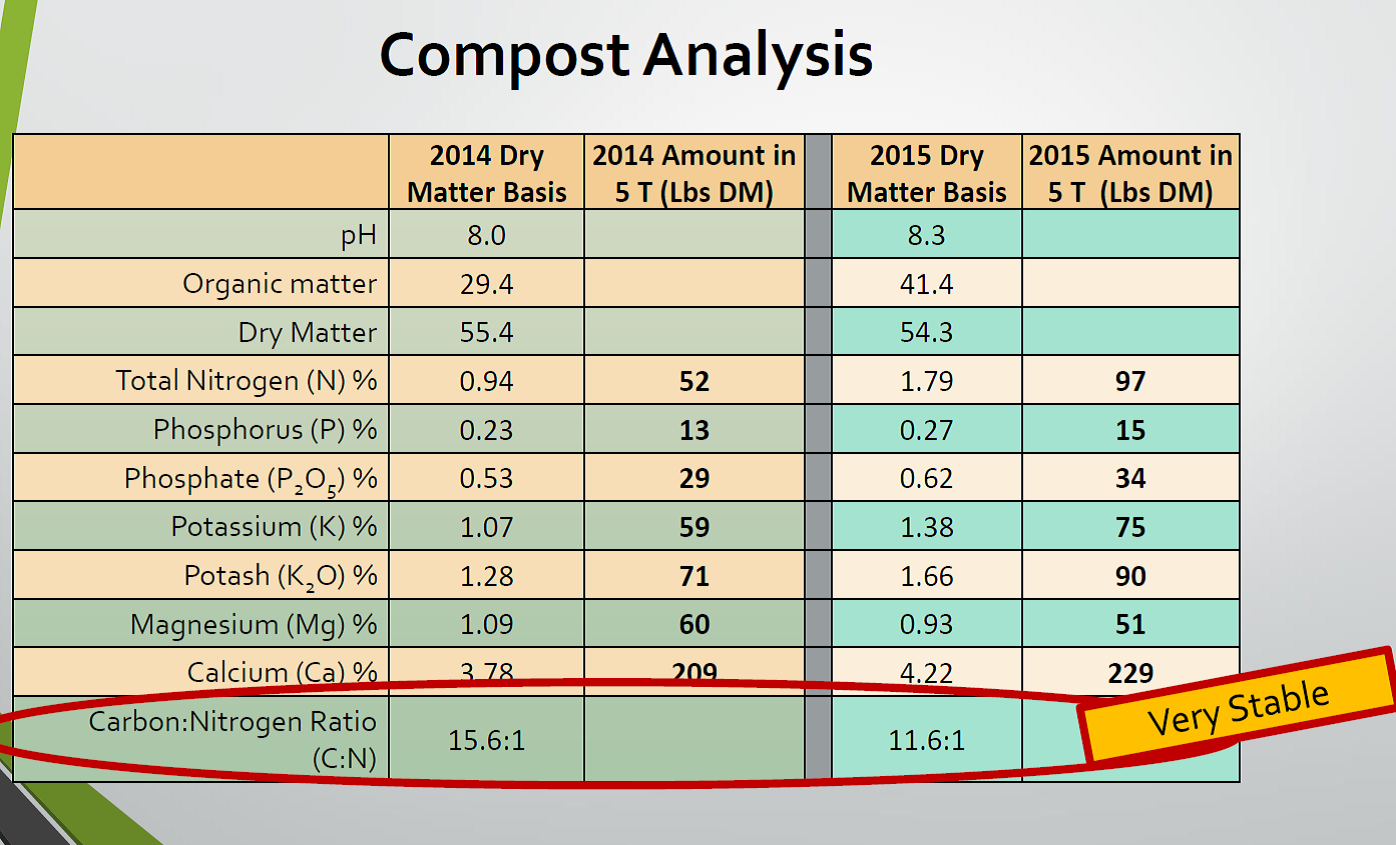
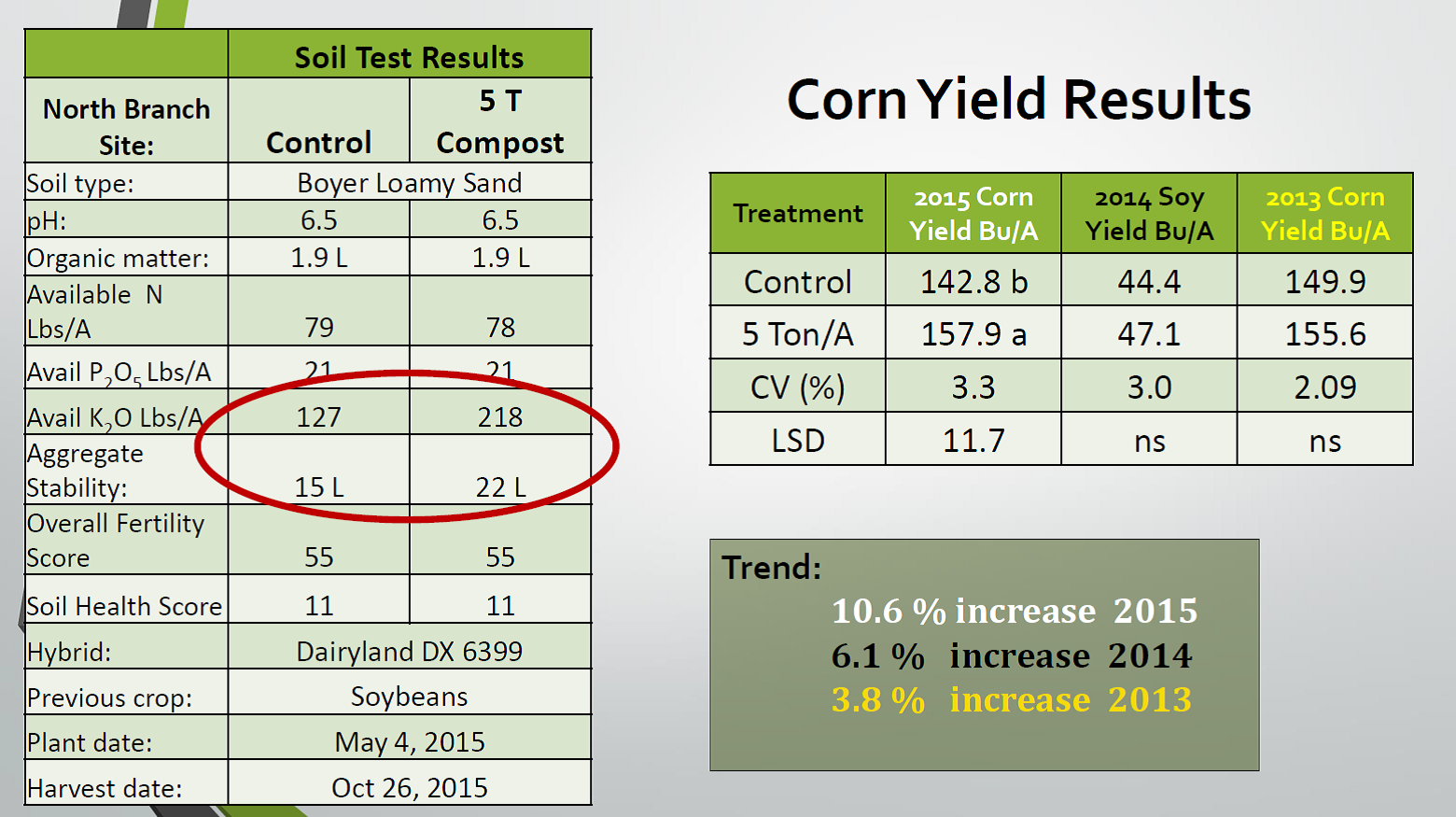
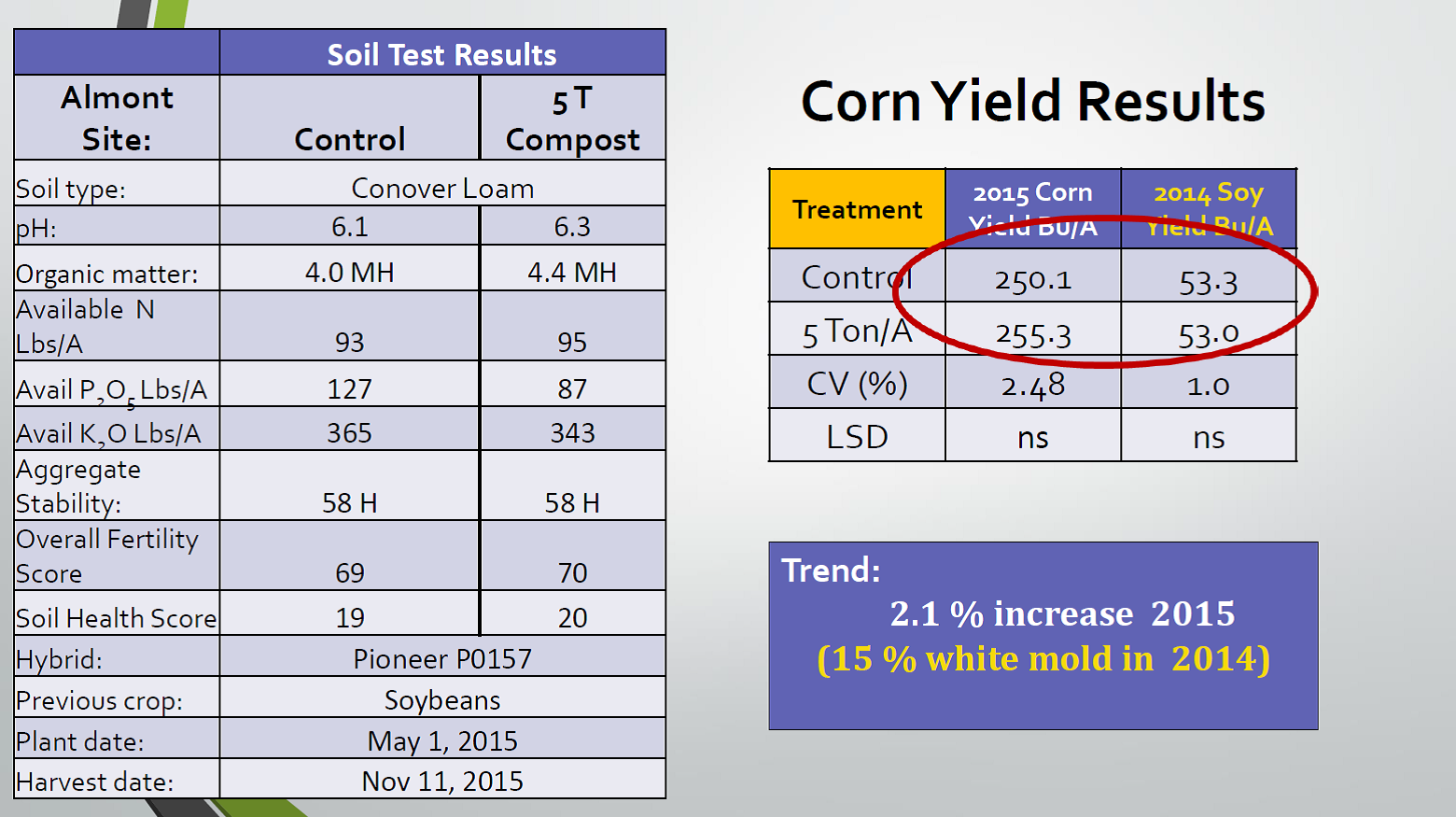
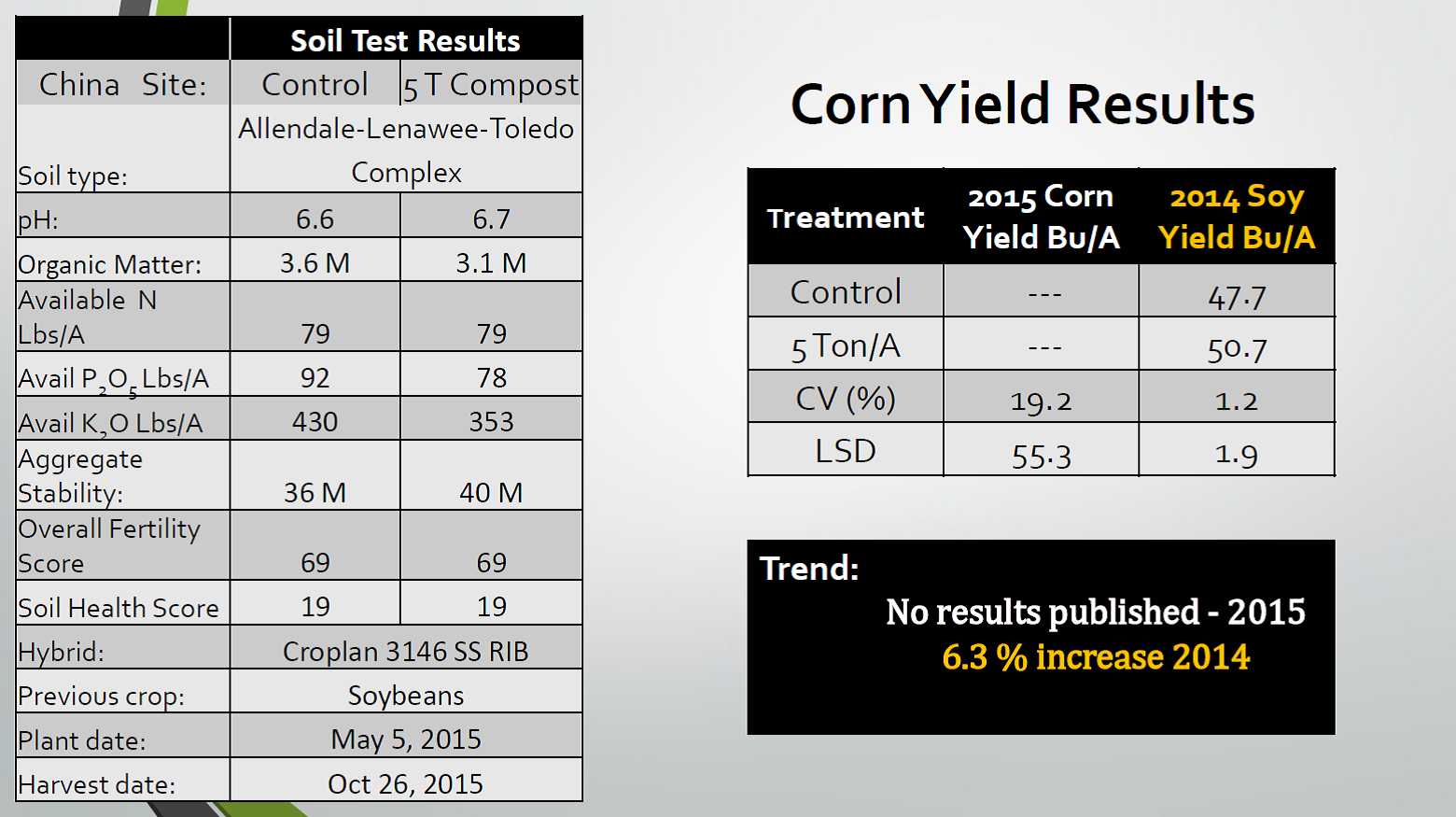
Soil test results:

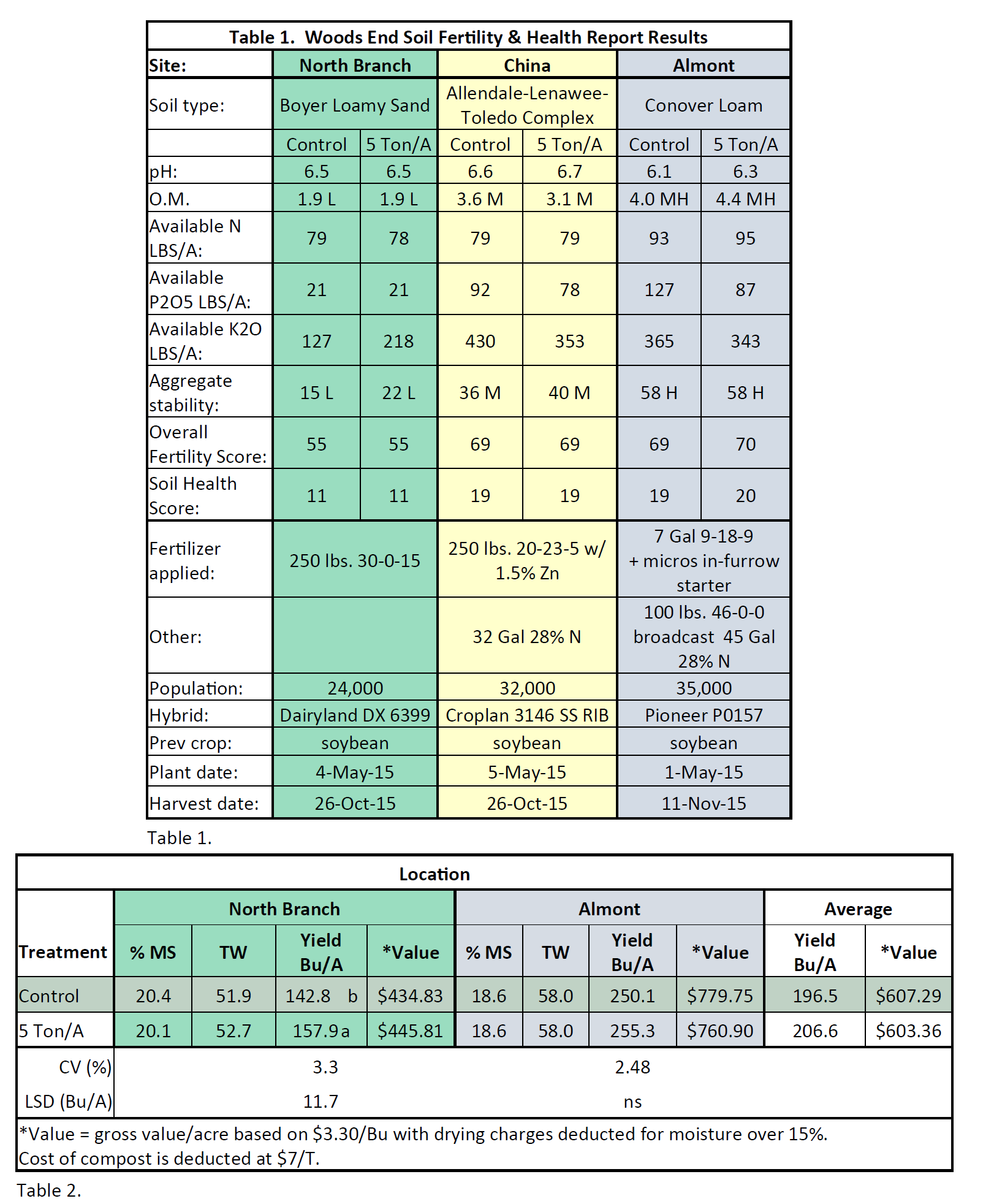
DISCUSSION
There were serval overall observations from this project. One should not expect short-term miracles in increased soil health and fertility using compost. Research indicates it likely takes three years to change the microbial population in the soil. Compost varies in composition from year-to-year depending on the makeup of the incoming materials.
Our farm may consider using yard waste compost in future years to build soil quality. It would be interesting to see if there is a synergistic effect with manure application or use of cover crops. There should be continued benefits for additional years beyond the initial application of compost. If the compost product can be obtained at a reasonable rate and trucking is cost effective or close, this could be beneficial. Further experimentation needs to be done to determine if it really would pay to use this compost in a corn-soybean rotation.
PROJECT IMPACTS
The economic benefits of applying yard waste compost to a corn-soybean rotation do not appear to be significant over a two-year period. Increased time of applying the compost may improve the yields significantly to show an economic value to applying yard waste compost to a corn-soybean rotation. At the North Branch location, the value (gross value/acre based on $3.30/bu with drying charges deducted for moisture over 15%; cost of compost is deducted at $7/ton) of the corn crop with 5 ton/acre compost applied ($445.81) was not different than the control ($434.83). At the Almont location, there was also no difference in the value of the 5 ton/acre compost applied ($760.90) compared to the control ($779.75). There is potential for environmental and social impacts by reducing the amount of yard waste from a large metropolitan area going into landfills by diverting the waste to a compost stream. There was no difference in soil test results after two years of applying yard waste compost at 5 ton/acre.
OUTREACH
Two field days were held to promote this project. In 2014, there were about 45 farmers in attendance. A field demonstration of applying the yard waste compost was done using a rear beater-bar manure spreader. Participants were able to view and handle the compost prior to application and observe spreading. Additionally, educators from Michigan State University, Charles Gould and Phil Kaatz, provided educational programming on compost use, application, and soil quality. We also described the project to participants. In 2015, there were about 20 farmers in attendance. The weather did not cooperate and rained, thus attendance was impacted. A specialist from Michigan State University, Dr. John Biernbaum, and educators Charles Gould and Phil Kaatz provided educational programming related to benefits of compost use. The preliminary results of the project from 2014 were also presented.
Results of this project were included in the Michigan State University Extension’s Thumb Agriculture Research and Education (TARE) winter programming. There were at least 200 participants present over five locations each year. Project results were included as a two page spread in the TARE publication each year (available online at: http://msue.anr.msu.edu/program/info/tare_variety_trials). In addition to the online version, 1,800 hard copies of the books were distributed to farmers throughout a five county area (Huron, Sanilac, Tuscola, Lapeer, and St. Clair counties) in Michigan.
The grant project was picked up by a local newspaper as well. http://voicenews.com/articles/2014/05/31/life/doc5388e2a3aaab7836271568.txt
PROGRAM EVALUATION
Thank you for the opportunity to participate in this project!
Introduction:
[Editor's Note: To see the report with tables, open the attached PDF version.]FRG_Final_Report_FNC14-976
PROJECT BACKGROUND
Schweihofer Farms is a crop/livestock operation with approximately 1,000 acres of crops grown annually. Our rotation includes corn, soybeans, wheat, and alfalfa/grass hay. The livestock portion includes 150 cattle in a beef feedlot and 15 llamas used in a breeding operation. We use vertical tillage for corn production and no-till for soybean and wheat production. In addition to the farm, my wife Jeannine and I have started Schweihofer Seed Sales LLC, as a way to increase our net farm income. Our farm is a fourth generation farm and we have been actively trying to build the soils. We have a combination of soil textures that range from heavy clay to sandy loam and they continue to be a challenge. In both the clay soils and the sandy loams we have limited soil organic matter. While manure has been one way for us to build soil organic matter there are insufficient amounts for the acres we farm. I have been actively involved in the area and previously served as the president of the St. Clair County Farm Bureau.
Our farm has been practicing no-till for the past 13 years. Vertical tillage is used on corn acreage in recent years.
PROJECT DESCRIPTION
GOALS
Compost has been used in many different types of farming operations primarily in horticulture and vegetable production; however in this area there has not been a source of compost large enough to supply the needs of grain crop farmers in the area. The objective of this grant is to find out how much compost should be applied in a corn/soybean rotation to see a sustainable response and then consider the economic sustainability. The goal was to determine if an economical rate of compost will maintain crop yields, increase soil quality, and reduce commercial fertilizer use.
PROCESS
Each farmer cooperator applied yard compost (commercially composted grass, leaves, and branches) at a rate of 5 ton/acre plus a control for two years. The 2.5 ton/acre treatment was eliminated because it was too difficult to calibrate the spreading of compost at that rate. The compost was applied in the same field at each of the three farms with a corn/soybean rotation.
Strips up to 1200 feet long, and wide enough to combine (dependent on each farms harvesting equipment), were established to receive compost in the spring and be incorporated into the soil prior to planting. Each application was done using a rear beater-bar spreader. The side slinger spreader did not work because the application rate could not be controlled and the compost remained in the bottom of the spreader. A random complete block design was used with three or four replications on the same strips for each year of the corn and soybean field. Normal fertilizer rates were applied to the fields as the compost builds soil quality, and soil organic matter. Soil tests pre and post testing were taken for each field to determine the level of soil buildup at the completion. Woods End Soil Laboratory (Mount Vernon, ME) utilized the USDA-ARS H3A Extraction Method soil test. In addition, they utilized Solvita CO2 respiration Yield, moisture and test weight were measured for each replication and treatment.
PEOPLE
Steve Listwak, farmer, project collaborator
2960 Burnside Road
North Branch, MI 48461
Crop/livestock farm in combination with a beef cow/calf grazing operation. The cropping operation is approximately 275 acres of owned and rented land, which includes 50 irrigated acres, 40 acres of pasture, and 80 acres of alfalfa/grass mix. Crops include corn, soybeans, rye, alfalfa, and grass. The livestock operation includes 35 Angus crossed brood cows. Soil textures are predominantly sandy loams.
Gordon Spencer, farmer, project collaborator
Spencer Farms Inc.
8151 Dryden Road
Almont, MI 48003
Spencer Farms is a cash cropping system of 1760 acres that includes 130 acres of wheat and a 50:50 corn soybean rotation. Combinations of conventional tillage, vertical tillage and no-till are all used in the operation. No-till is used primarily for wheat and soybean acres. To build soil quality, the farm has started using cereal rye as a cover crop. Soil textures range from clay loams to sandy loam.
Phil Kaatz, Michigan State University Extension Educator
Forages/Field Crops
1800 Imlay City Rd.
Lapeer, MI 48446
Mr. Kaatz was involved with the planning, execution and outreach components of the project. He has been influential in the region regarding compost usage in cropping systems and has helped initiate projects to evaluate the use of yard waste compost. He has statewide responsibilities for forages and also has field crops responsibilities in a nine county area that includes 40% of Michigan’s corn production.
Charles Gould
Michigan State University Extension Educator
Bioenergy and Energy Conservation
12220 Fillmore St, Suite 122
West Olive, MI 49460
Mr. Gould participated as a speaker at both summer field days. He has extensive experience with compost and utilizing it in various farming operations.
Bob Brooks
Fred Thompson
Indian Summer Recycling
5877 Bethuy Rd.
Casco Twp., MI 48064
Mr. Brooks and Mr. Thompson are owners and operators of Indian Summer Recycling and provided the yard waste compost for the project.
RESULTS
Overall observations for the project include: Do not expect short-term miracles in increased soil health and fertility using compost. Research indicates that it takes three years to change the microbial population in the soil. Compost varies in composition from year to year depending on the makeup of the incoming materials. Two years appears to be too short of a time to be a value over and above the cost of the compost plus application costs. A combination of compost, manure, and cover crops may provide added benefits to increased soil activity, fertility, and health. The benefits should continue for more than one year after application. Long term benefits of compost include: improving CEC, building soil organic matter, improving aggregate stability, better pore spaces in the soil, stimulation of the microbial population, and increased water holding capacity.
The economic feasibility of using the yard waste compost includes assumptions at these values: corn price $3.30/bushel, compost cost $7.00/ton (yard), freight cost $4.00/ton (yard) ($200/load = distance charge, each load is 50 yards), application cost $4.00/ton (yard).
Compost analysis:
The North Branch project cooperator tried compost application the year prior (2013) to the start of this project and had three years of data. The crop response was greater this year than in any previous year. There was a statistical yield difference in 2015. There was a dramatic visual difference in the corn during the growing season as well. Crop response was greater than the cost of the compost for this site. There was a consistent yield response over a three year period at this site.
The Almont site had a tremendous corn crop in 2015 with an average of 250 bushels/acre. In 2014, there was a 15% prevalence of white mold present in the soybeans and no difference was seen between the compost trial and the control.
The China site was not able to use the 2015 data because of extreme amounts of rainfall experienced from just after the time of planting throughout the growing season. The yield data had high variability. There was a trend for a 6.3% increase in soybean yield in 2014.
DISCUSSION
There were several overall observations from this project. One should not expect short-term miracles in increased soil health and fertility using compost. Research indicates it likely takes three years to change the microbial population in the soil. Compost varies in composition from year-to-year depending on the makeup of the incoming materials.
Our farm may consider using yard waste compost in future years to build soil quality. It would be interesting to see if there is a synergistic effect with manure application or use of cover crops. There should be continued benefits for additional years beyond the initial application of compost. If the compost product can be obtained at a reasonable rate and trucking is cost effective or close, this could be beneficial. Further experimentation needs to be done to determine if it really would pay to use this compost in a corn-soybean rotation.
PROJECT IMPACTS
The economic benefits of applying yard waste compost to a corn-soybean rotation do not appear to be significant over a two-year period. Increased time of applying the compost may improve the yields significantly to show an economic value to applying yard waste compost to a corn-soybean rotation. At the North Branch location, the value (gross value/acre based on $3.30/bu with drying charges deducted for moisture over 15%; cost of compost is deducted at $7/ton) of the corn crop with 5 ton/acre compost applied ($445.81) was not different than the control ($434.83). At the Almont location, there was also no difference in the value of the 5 ton/acre compost applied ($760.90) compared to the control ($779.75). There is potential for environmental and social impacts by reducing the amount of yard waste from a large metropolitan area going into landfills by diverting the waste to a compost stream. There was no difference in soil test results after two years of applying yard waste compost at 5 ton/acre.
OUTREACH
Two field days were held to promote this project. In 2014, there were about 45 farmers in attendance. A field demonstration of applying the yard waste compost was done using a rear beater-bar manure spreader. Participants were able to view and handle the compost prior to application and observe spreading. Additionally, educators from Michigan State University, Charles Gould and Phil Kaatz, provided educational programming on compost use, application, and soil quality. We also described the project to participants. In 2015, there were about 20 farmers in attendance. The weather did not cooperate and rained, thus attendance was impacted. A specialist from Michigan State University, Dr. John Biernbaum, and educators Charles Gould and Phil Kaatz provided educational programming related to benefits of compost use. The preliminary results of the project from 2014 were also presented.
Results of this project were included in the Michigan State University Extension’s Thumb Agriculture Research and Education (TARE) winter programming. There were at least 200 participants present over five locations each year. Project results were included as a two page spread in the TARE publication each year (available online at: http://msue.anr.msu.edu/program/info/tare_variety_trials). In addition to the online version, 1,800 hard copies of the books were distributed to farmers throughout a five county area (Huron, Sanilac, Tuscola, Lapeer, and St. Clair counties) in Michigan.
The grant project was picked up by a local newspaper as well. http://voicenews.com/articles/2014/05/31/life/doc5388e2a3aaab7836271568.txt
PROGRAM EVALUATION
Thank you for the opportunity to participate in this project!
Project objectives:
The goal is to try to build soil quality and soil organic matter through the use of yard waste compost in a corn/soybean rotation while possibly reducing commercial fertilizer usage.